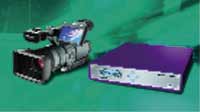
Bob Pank
|
LAS VEGAS …quot; At the NAB convention last month, I found a huge HD presence, and while this may not reflect the proportion of high definition production today, it is surely a message for the near future. Sony declared that half of its sales in 2004 were for HD products, and most manufactures now have HD offerings in their product lines. Certainly for post it is not the big financial deal that it once was.
Buying patterns in the affordable area are shifting as interest in the "do-it-yourself" approach to edit system assembly is giving way to keenly-priced, off-the-shelf workstations. It is true that there are many sub-assemblies, such as I/O cards, for computer-based equipment, but knowing how to avoid software and hardware conflicts and achieve optimal performance is recognized as a job for the experts.
Tim Lawrence, VP operations/technology, at Boxx Technologies (www.boxxtech.com/) sees their roll shifting to not only delivering the ideal platform but also to adding more support. "Video has now become more complex. There are different decks, inputs and outputs, formats and requirements to optimize workflow. So the customer needs support before and after the fact. We are getting more involved with certification and authorizing configurations." At the same time Boxx, which didn't have a booth at NAB but had product at partner booths, continues to offer a range of video workstations: HDPro for uncompressed quality and HDProRT for realtime performance using Cineform compression.

Miranda's new HD-Bridge DEC can convert HDV 720p to 1080i.
|
I Beyond (www.1beyond.com/) has been offering HD editing for three years and has made inroads into the affordable HD market. This year CEO Terry Cullen reports, "We've broken the $15,000 barrier. The $14,995 price tag showing on the tower unit [Pro HD Flex] has attracted a lot of attention." For this you get considerable storage and performance, as well as Adobe Premiere Pro software and HD-SDI I/O. There is 1TB of storage, equating to around two hours of uncompressed HD, and dual 3.6GHz Xeon with 800MHz FSB for processing. The system uses PCI Express, which was everywhere on the show floor. Cullen continues, "Last year we had realtime and compression. This year it's realtime and uncompressed. This is the end of the compromise."
The system offers single-channel HD realtime processing …quot; like a fade to black. So, how long would a dissolve take? Cullen reports, "Time is not so much of an issue." And that's an interesting point: For many, this system is fast enough. But then Cullen points out that, "In HD, one size does not fit all." So, for those wanting a bit more there's the double-width tower of the Pro HD. With storage ranging from 2.5TB to 12TB and a sustained transfer speed of 400MB/s, there is more than enough for two HD channel operation …quot; but at twice the price. 1 Beyond has been partnering with Sanbolic and DigiNovations to provided extended storage from a 4.8TB RAID to a 4GB/s Fibre Channel SAN for realtime HD file sharing.
Avid (www.avid.com/) has expanded HD to their entire edit range. By using the free codec for DNxHD, a $1,700 Xpress Pro or a $25K Media Composer can become an HD video editor as the compressed video has low enough data to fit within SD bandwidth and infrastructure.

Using hardware assist to achieve realtime HD processing, Matrox's Axio is capable and fast.
|
Matrox Axio (www.matrox.com/) was a newcomer to NAB. Announced late last year, the first product is now about to ship. Using hardware assist to achieve a good degree of realtime HD processing, Axio is very capable and fast. For editors, there is good familiarity with Adobe Premiere Pro editing software that should be an easy step for FCP editors, and there's Adobe After Effects-like operation for effects. With platform support from HP, there is commitment from all three companies. The result is a very capable package at affordable prices from $11,495 to around $35K. Realtime performance stretches to handling two video channels, two graphics channels and effects at 10-bit resolution. Primary and secondary color correction are realtime and are designed for quick operation. And there is still room for a little final pizzazz like elegant page curls and realtime blur.
HDV
HDV is everywhere. Now it seems all edit systems offer working HDV. Perhaps the most significant adopter is Apple (www.apple. com/) with Final Cut Pro 5 now supporting native HDV. Apple also introduced Final Cut Studio, including SD, DV and HD editing with Motion 2 graphics, Soundtrack Pro audio and SD and HD DVD authoring features of DVD Studio Pro 4.
Most edit systems take in native HDV via IEEE 1394, but Miranda (www.miranda.com/) has once again found a way to improve workflow with another interface box. Its new HD-Bridge DEC solves a couple of problems. First, HDV compression is designed for acquisition and not editing. The images are coded into long groups of pictures (GOPs) and need to be decoded to edit with frame accuracy. Also, the compression is very high, so multi-generation decode/recode cycles are to be avoided. With uncompressed HD post now easily available, it makes sense for any professional to decode only once and continue working uncompressed through to the master. The bridge also has a cross-converter between 1080i and 720p, which is useful as Sony HDV cameras record 1080i and JVC 720p. It also embeds audio and timecode, along with digital and analog video/audio outputs. Available in June this box should prove to be well worth its under $3K price tag.